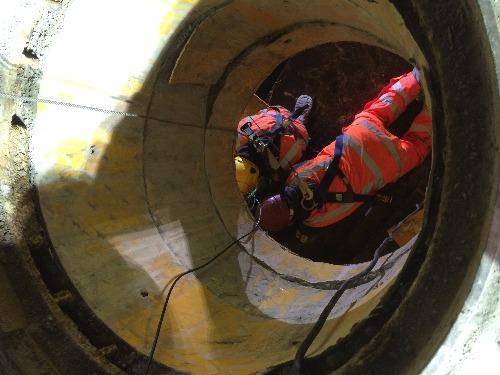Workers enter confined spaces every day. And every day, Emergency Services are the sole rescue plan for these potential events that may occur in manholes, sewers, tanks, silos and pits to name a few. Most workers enter confined spaces with the expectation that they will be rescued if something goes wrong. But if a crew's only rescue plan is to call 111 in the event of a problem, that rescue may not be possible.
If a situation arises where there is a hazardous condition and the worker does not leave or is unable to leave the confined space, rescue procedures should be begin immediately.
The Safety Watch in place should be qualified in confined space rescue procedures and should be available immediately outside the confined space to provide emergency assistance if and when required. The Safety Watch should also be familiar with the structural design of the confined space. One of the Safety observers role is to be in constant communication with the worker inside the confined space and should:
- Have an alarm for calling for help.
- Have all required rescue equipment (for example, safety harnesses, lifting equipment, a lifeline) immediately available and be trained in its use.
- Hold a first aid certificate.
The detailed plan for emergency response to an injury or other emergency within the confined space should be described in detail in the Confined Space safety analysis and permits.
When putting together an emergency plan the following should be taken into consideration:
EMERGENCY PLANNING
This identifies the personnel, equipment and skills required; for emergencies, evacuations and/or rescues.
In order to plan for an emergency correctly and practically you must:
- List the things that could happen;
- Decide on priority of procedures and tasks;
- Set up training to cover the "What if" factor;
- Provide and place emergency equipment correctly, so that they are handy enough to be used immediately if the need arises;
- Contact emergency services for "turn-out" times in the area;
- Review plans on a regular basis.
Every confined space entry is different and every entry needs its own Emergency Plan. This should simply be part of the Job Safety Analysis of each Confined Space entry.
RESCUE PLANNING
Before any confined space activity may begin, and as part of the permit process, one must ensure that an appropriate rescue plan and first aid procedures and provisions are considered, established and rehearsed.
All personnel who may be involved with a confined space rescue are to:
- Be made aware of the rescue plan;
- Rehearse rescue procedures prior to the confined space entry;
- All procedures are to be adhered to at all times;
- Rescue means are to remain on site at all times whilst the confined space activities are being conducted.
Ensure that openings for Entry and Exit to a confined space are of adequate size to permit rescue of all personnel within the confined space and the path between the workers and the opening are clear and free of equipment.
A rescue plan should consider:
- The rescue method, i.e. non-entry rescue, rescue by personnel in BA
- Available equipment i.e. Harness, safety line, retrieval device
- Responsibilities and training, i.e. First Aider, Supervisor, Safety Observer
- Communication, i.e. Method and numbers to dial
- Medical requirements, i.e. First Aid kit, stretcher, resuscitation kits
- Involving the emergency services.
There are 3 methods of performing a rescue:
- Conducting a self rescue – by climbing or crawling oneself to a safe area
- Conducting a non-entry rescue – by engaging a hauling line that is already attached to the casualty
- Entry rescue – by emergency response/fire service team qualified in wearing breathing apparatus (BA) equipment.
If the casualty is conscious a combination of the three methods is achievable however if the casualty is unconscious where they are unable to aid in their rescue a reliance on a qualified BA rescue team to perform the task becomes a priority. The rescue team needs to be aware of the hazards and any new hazards before attempting a rescue.
Once the rescue plan has been established it must be communicated to the work and rescue teams.
More careful planning may be required for extreme situations:
- Elimination and Minimisation.
- Site evacuation
- Entry and exit points are identified
- Casualty evacuation point identified
- Times for rescue team to conduct rescue and casualty evacuation
- Standby teams are ready
- Resting and rotating multiple teams and groups.
